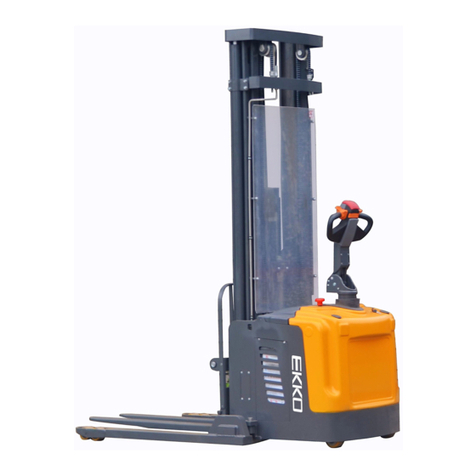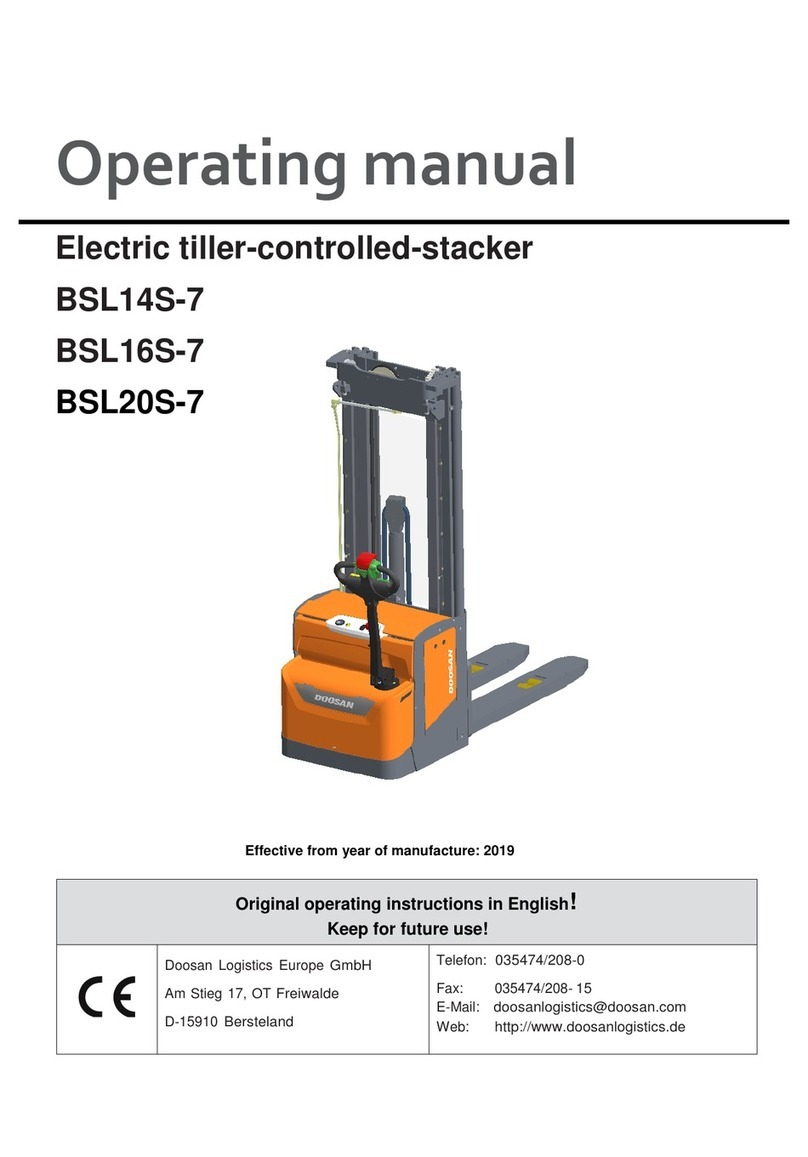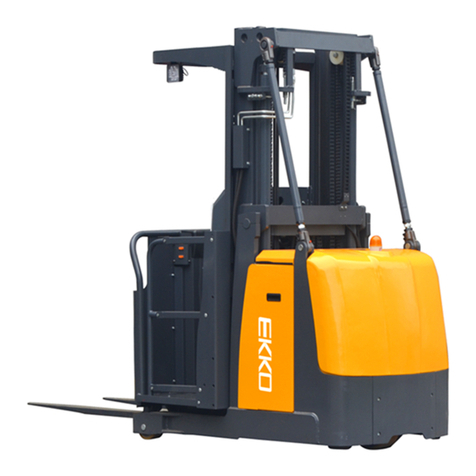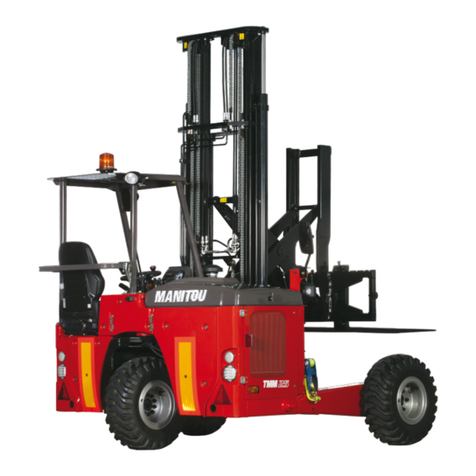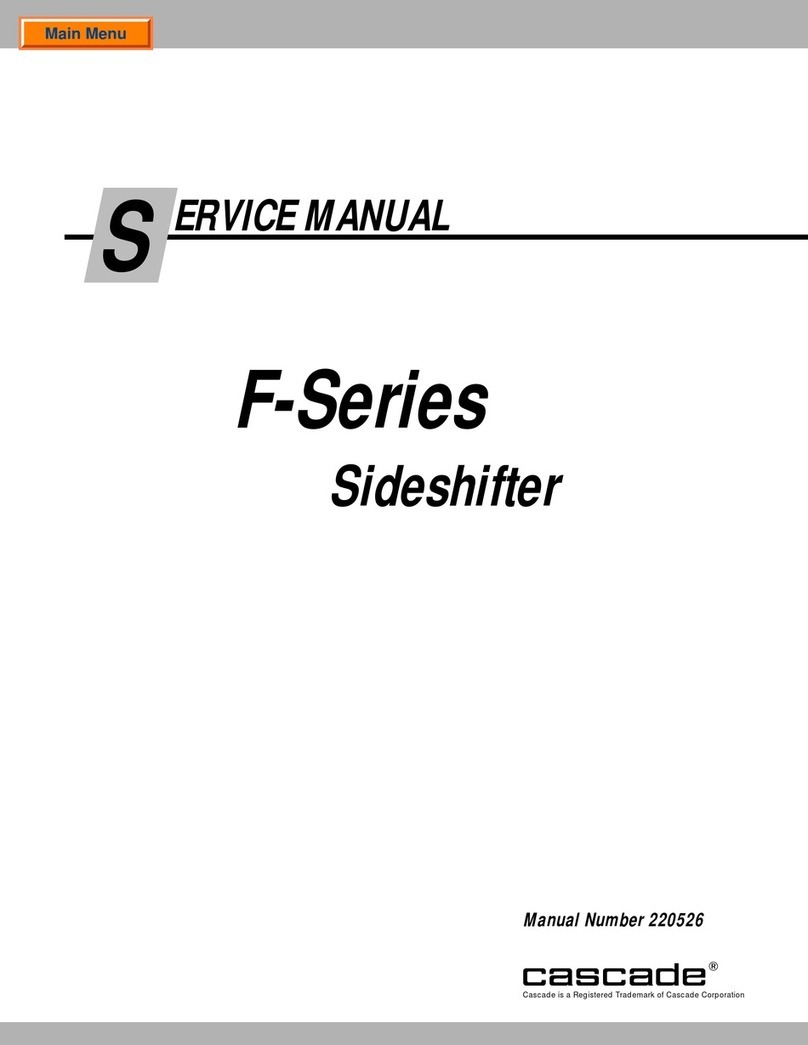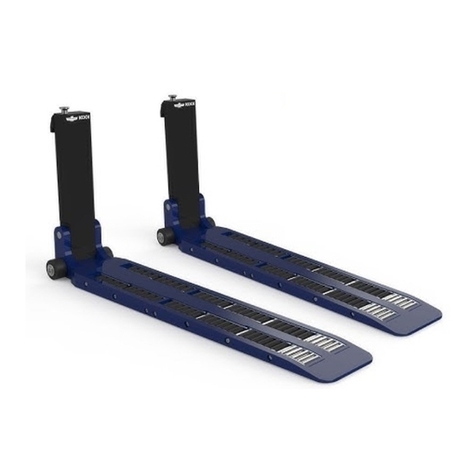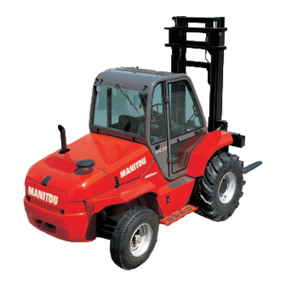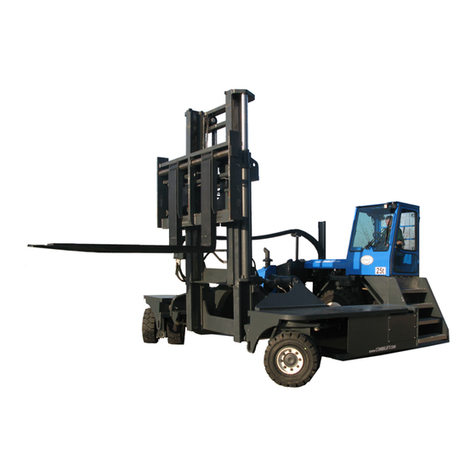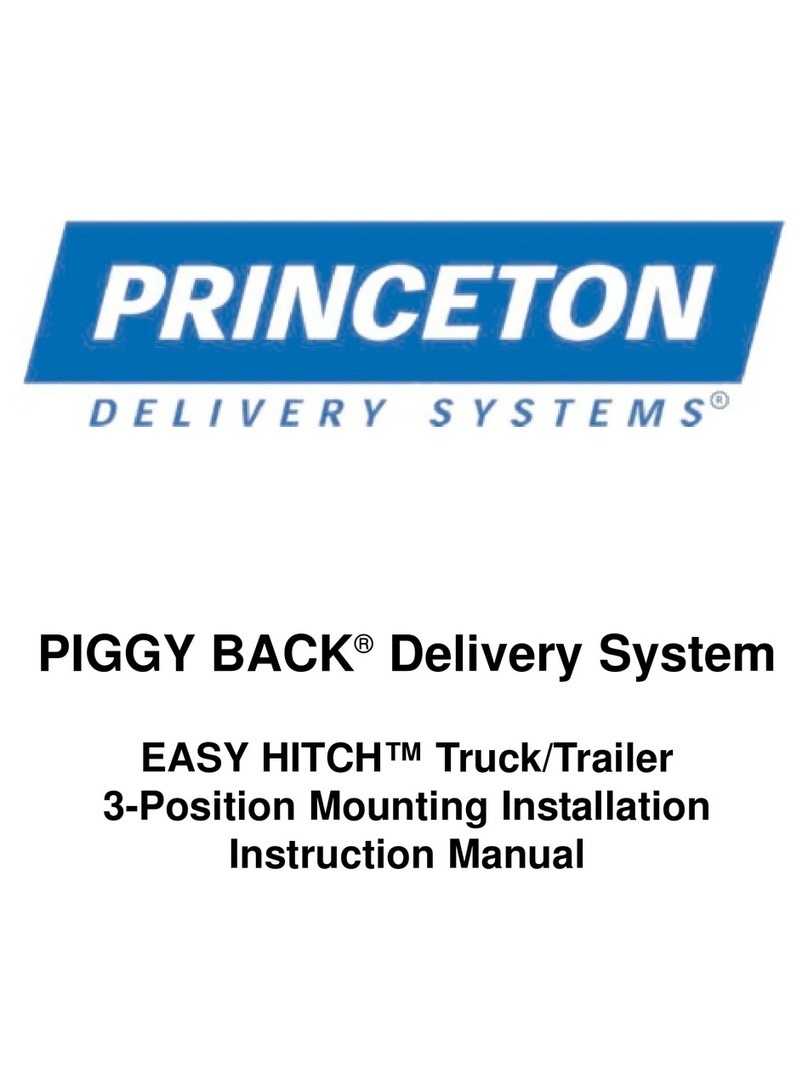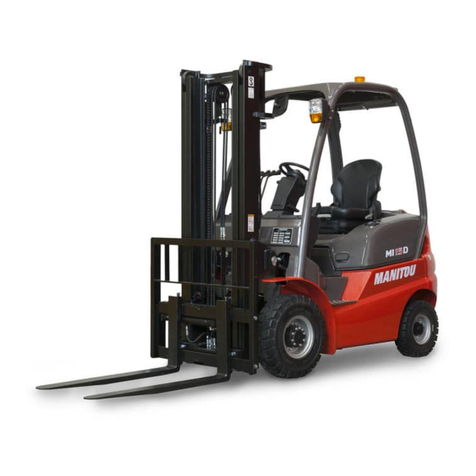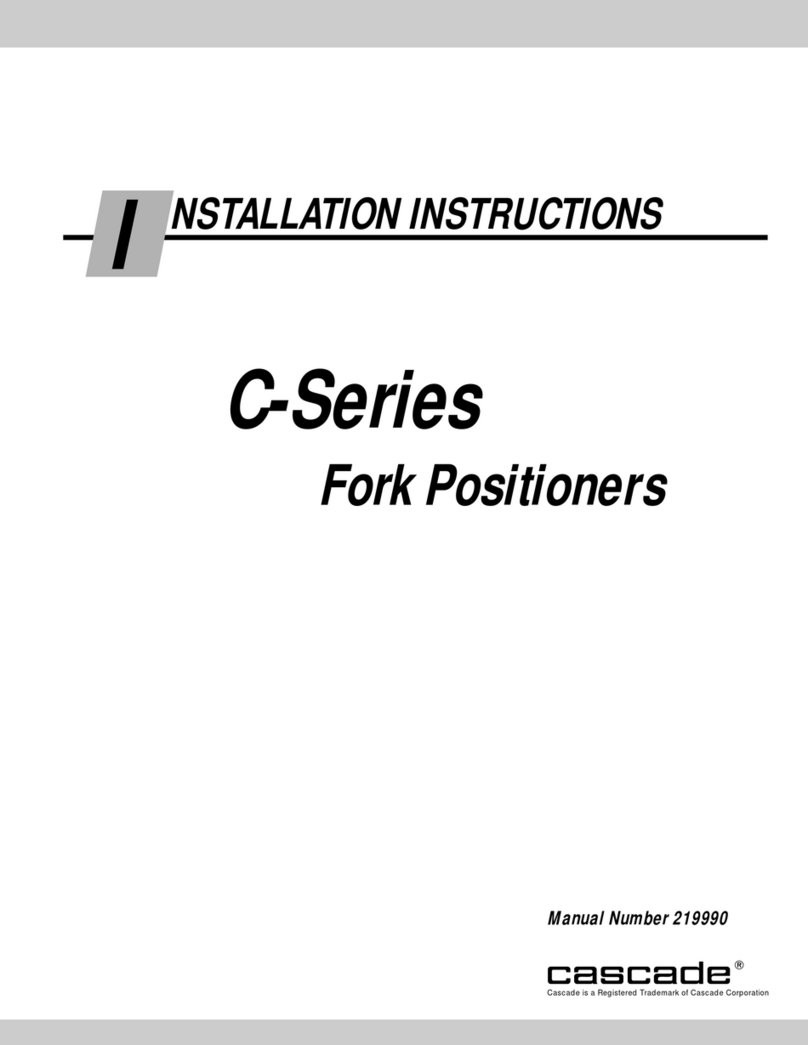CMCO TIGRIP TKG 1,0 vh User manual

TIGRIP
DE - Original Betriebsanleitung (gilt auch für Sonderausführungen)
Krangabel
TKG vh
Columbus McKinnon Industrial Products GmbH
Yale-Allee 30
42329 Wuppertal
Deutschland

2
© 2016 Columbus McKinnon Industrial Products GmbH
Inhaltsverzeichnis
Vorwort...................................................................................................................................3
Bestimmungsgemässe Verwendung....................................................................................3
Sachwidrige Verwendung .....................................................................................................5
Prüfung vor der ersten Inbetriebnahme...............................................................................6
Prüfung vor Arbeitsbeginn ...................................................................................................6
Gebrauch des Lastaufnahmemittels ....................................................................................7
Prüfung / Wartung .................................................................................................................8
Transport, Lagerung, Ausserbetriebnahme und Entsorgung.............................................9

3
© 2016 Columbus McKinnon Industrial Products GmbH
VORWORT
Produkte der CMCO Industrial Products GmbH sind nach dem Stand der Technik und den
anerkannten gültigen Regeln gebaut. Durch unsachgemäße Handhabungen können dennoch
bei der Verwendung der Produkte Gefahren für Leib und Leben des Benutzers oder Dritter
auftreten bzw. Beschädigungen am Hebezeug oder anderen Sachwerten entstehen.
Das Bedienpersonal muss vor Arbeitsbeginn eingewiesen worden sein. Dazu ist die
Betriebsanleitung von jedem Bediener vor der ersten Inbetriebnahme sorgfältig zu lesen.
Diese Betriebsanleitung soll erleichtern, das Produkt kennen zu lernen und die
bestimmungsgemäßen Einsatzmöglichkeiten zu nutzen. Die Betriebsanleitung enthält wichtige
Hinweise, um das Produkt sicher, sachgerecht und wirtschaftlich zu betreiben. Ihre Beachtung
hilft Gefahren zu vermeiden, Reparaturkosten und Ausfallzeiten zu vermindern und die
Zuverlässigkeit und Lebensdauer des Produktes zu erhöhen. Die Betriebsanleitung muss
ständig am Einsatzort des Produktes verfügbar sein. Neben der Betriebsanleitung und den im
Verwenderland und an der Einsatzstelle geltenden verbindlichen Regelungen zur
Unfallverhütungsvorschrift sind auch die anerkannten Regeln für sicherheits- und
fachgerechtes Arbeiten zu beachten.
Das Personal für Bedienung, Wartung oder Reparatur des Produktes muss die Anweisungen
in dieser Betriebsanleitung lesen, verstehen und befolgen.
Die beschriebenen Schutzmaßnahmen führen nur dann zu der erforderlichen Sicherheit, wenn
das Produkt bestimmungsgemäß betrieben und entsprechend den Hinweisen installiert bzw.
gewartet wird. Der Betreiber ist verpflichtet, einen sicheren und gefahrlosen Betrieb zu
gewährleisten.
BESTIMMUNGSGEMÄSSE VERWENDUNG
Das Lastaufnahmemittel dient dem sicheren Transport von palettierten Gütern und Waren, die
aufgrund ihrer Form und Abmessungen sicher von den Gabelzinken aufgenommen werden
können.
ACHTUNG: Unbedingt Hinweise zur Verwendung auf Baustellen beachten.
Eine andere oder darüber hinausgehende Benutzung gilt als nicht bestimmungsgemäß. Für
hieraus resultierende Schäden haftet die Firma Columbus McKinnon Industrial Products
GmbH nicht. Das Risiko trägt allein der Anwender/Betreiber.
Die auf dem Gerät angegebene Tragfähigkeit (WLL) ist die maximale Last, die angeschlagen
werden darf.
Die angegebene Tragfähigkeit gilt bei einem Abstand des Lastschwerpunktes von 400 mm
bzw. 500 mm (halbe Zinkenlänge) vom Holm.
Lastschwerpunkt
Load centre of gravity
Load centre of gravity
F
Xmax.

4
© 2016 Columbus McKinnon Industrial Products GmbH
Außerhalb des bodennahen Bereiches, bzw. auf Baustellen, muss die Last durch die
mitgelieferte, straff zu spannende Sicherungskette gesichert sein. Zum Befestigen der Kette
sind am senkrechten Holm Ösen angebracht.
Bei ordnungsgemäßer Positionierung der Last und der Aufhängeöse senkrecht über dem
Lastschwerpunkt muss der Neigungswinkel im angehobenen Zustand min. 5° nach hinten (in
Richtung senkrechtem Holm) betragen.
Beim Transport von losen Materialien wie z.B. Dachziegeln oder Bausteinen auf Baustellen
muss zum Schutz vor Herabfallen zusätzlich ein geeignetes Netz oder ein geeigneter Käfig
verwendet werden.
HINWEIS: Die Öffnungen der Schutzeinrichtung müssen kleiner als 50 mm² sein (siehe
Merkblatt "Paketierte Steine auf Baustellen" ZH 1/335).
Der Aufenthalt unter einer angehobenen Last ist verboten.
Lasten nicht über längere Zeit oder unbeaufsichtigt in angehobenem oder gespanntem
Zustand belassen.
Der Bediener darf eine Lastbewegung erst dann einleiten, wenn er sich davon überzeugt hat,
dass die Last richtig angeschlagen ist und sich keine Personen im Gefahrenbereich aufhalten.
Beim Einhängen des Lastaufnahmemittels ist vom Bediener darauf zu achten, dass das
Lastaufnahmemittel so bedient werden kann, dass der Bediener weder durch das Gerät selbst
noch durch das Tragmittel oder die Last gefährdet wird.
Vor dem Einsatz des Lastaufnahmemittels in besonderen Atmosphären (hohe Feuchtigkeit,
salzig, ätzend, basisch) oder der Handhabung gefährlicher Güter (z.B. feuerflüssige Massen,
radioaktive Materialien) ist mit dem Hersteller Rücksprache zu halten.
Das Lastaufnahmemittel kann in einer Umgebungstemperatur zwischen –40 °C und +100 °C
eingesetzt werden. Bei Extrembedingungen muss mit dem Hersteller Rücksprache genommen
werden.
Der Steckbolzen zur Höhenverstellung des Grundgestell-Oberteils ist immer mit dem
Sicherungsclip zu sichern.
Der Transport des Hebegutes sollte immer langsam, vorsichtig und bodennah durchgeführt
werden.
Das Führen und Bedienen des Lastaufnahmemittels ist nur am Handgriff gestattet.
Verletzungsgefahr!
Beim Anheben und Absetzen auf stabile Lage der Last achten, um Unfälle durch Kippen,
Rollen oder Stürze zu vermeiden. Dies gilt auch für Lasten, die daneben und darunter lagern.
Der Bediener sollte immer in einem Sicherheitsabstand von einer Armlänge neben dem
Lastaufnahmemittel stehen.
Es dürfen nur Kranhaken mit Sicherungsfalle verwendet werden.
Die Aufhängeöse des Lastaufnahmemittels muss im Kranhaken genügend Platz haben und
frei beweglich sein.
Bei Funktionsstörungen ist das Lastaufnahmemittel sofort außer Betrieb zu setzen.
Lastschwerpunkt
Load centre of gravity
Load centre of gravity
min. 5°

5
© 2016 Columbus McKinnon Industrial Products GmbH
SACHWIDRIGE VERWENDUNG
(nicht vollständige Auflistung)
Die Tragfähigkeit (WLL) darf nicht überschritten werden.
Es darf nur Hebegut aufgenommen werden, dessen Abmessungen innerhalb der
angegebenen Grenzen für Nutzhöhe und Zinkenlänge liegen (Tab. 1). Die aufgenommene
Last darf die Länge der Gabelzinken keinesfalls überschreiten.
Das Lastaufnahmemittel muss sich im belasteten, angehobenen Zustand um mindestens 5°
nach hinten (in Richtung Holm) neigen, keinesfalls in die entgegengesetzte Richtung!
An dem Lastaufnahmemittel dürfen keine Veränderungen durchgeführt werden.
Die Benutzung des Lastaufnahmemittels zum Transport von Personen ist verboten.
Beim Transport der Last ist eine Pendelbewegung und das Anstoßen an Hindernisse zu
vermeiden.
Die Belastung des Lastaufnahmemittels mit seitlichen Zugkräften ist verboten.
Weder das Lastaufnahmemittel noch Teile davon dürfen als Tragmittel zum Anschlagen von
Seilen, Ketten oder Bändern verwendet werden.
Werden mehr als 2 Lastaufnahmemittel verwendet, muss zur Vermeidung von unzulässigen
seitlichen Zugkräften eine Traverse zum Einsatz kommen.
Mit der Krangabel dürfen nur Güter transportiert werden, die auf Paletten fest verschnürt sind
bzw. Güter, die aufgrund ihrer Form und Größe direkt von den Zinken aufgenommen werden
können.
ACHTUNG: Beim Anheben der beladenen Krangabel dürfen die Spitzen der Gabelzinken
keinesfalls nach unten weisen!
Lastaufnahmemittel nicht aus großer Höhe fallen lassen.
Das Gerät darf nicht in explosionsfähiger Atmosphäre eingesetzt werden.
Lastschwerpunkt
Load centre of gravity
Load centre of gravity
min. 5°

6
© 2016 Columbus McKinnon Industrial Products GmbH
PRÜFUNG VOR DER ERSTEN INBETRIEBNAHME
Laut bestehenden nationalen/internationalen Unfallverhütungs- bzw. Sicherheitsvorschriften
müssen Lastaufnahmemittel
• gemäß der Gefahrenbeurteilung des Betreibers,
• vor der ersten Inbetriebnahme,
• vor der Wiederinbetriebnahme nach Stilllegung
• nach grundlegenden Änderungen,
• jedoch mindestens 1 x jährlich durch eine befähigte Person geprüft werden.
ACHTUNG: Die jeweiligen Einsatzbedingungen (z.B. in der Galvanik) können kürzere
Prüfintervalle notwendig machen.
Reparaturarbeiten dürfen nur von Fachwerkstätten, die Original TIGRIP-Ersatzteile
verwenden, durchgeführt werden. Die Prüfung (im Wesentlichen Sicht- und Funktionsprüfung)
hat sich auf die Vollständigkeit und Wirksamkeit der Sicherheitseinrichtungen sowie auf den
Zustand des Gerätes, der Tragmittel, der Ausrüstung und der Tragkonstruktion hinsichtlich
Beschädigung, Verschleiß, Korrosion oder sonstigen Veränderungen zu erstrecken.
Die Inbetriebnahme und die wiederkehrenden Prüfungen müssen dokumentiert werden (z.B.
in der CMCO-Werksbescheinigung).
Auf Verlangen sind die Ergebnisse der Prüfungen und die sachgemäße
Reparaturdurchführung nachzuweisen.
Lackbeschädigungen sind auszubessern, um Korrosion zu vermeiden. Alle Gelenkstellen und
Gleitflächen sind leicht zu schmieren. Bei starker Verschmutzung ist das Gerät zu reinigen.
PRÜFUNG VOR ARBEITSBEGINN
Es ist darauf zu achten, dass die Gabelzinken möglichst fett-, farb-, schmutz-, zunder- und
beschichtungsfrei sind. Beim Einsatz im Freien ist ferner darauf zu achten, dass die Zinken
schnee- und eisfrei sind.
Das gesamte Lastaufnahmemittel ist auf Beschädigungen, Risse oder Verformungen hin zu
überprüfen.
Steckbolzen überprüfen. Der am senkrechten Holm angebrachte Steckbolzen zur Verstellung
der lichten Höhe muss gängig sein und durch den Klappstecker gegen Herausfallen gesichert
sein.
Die verstellbaren Gabelzinken müssen sichtbar eingerastet und verriegelt sein.

7
© 2016 Columbus McKinnon Industrial Products GmbH
GEBRAUCH DES LASTAUFNAHMEMITTELS
Entsprechend der zu transportierenden Last sind die Gabelzinken und der Holm auf die
erforderliche Breite bzw. Höhe einzustellen und durch die jeweiligen Verriegelungen zu
sichern.
Einstellung der Gabelzinkenbreite
• Verriegelung durch Drehen des Federriegels um 180° öffnen.
• Zinke auf die erforderliche Breite einstellen.
• Verriegelung durch Zurückdrehen des Federriegels aktivieren.
ACHTUNG: Der Federriegel muss sichtbar vollständig im Rahmen eingerastet sein.
Einstellung der Höhe des Grundgestell-Oberteils
• Sicherungsclip entfernen
• Die nutzbare Höhe durch Verstellen des Grundgestell-Oberteils der Hebeguthöhe anpassen.
• Das Grundgestell-Oberteil mit dem Bolzen in der Höhe fixieren und den Bolzen mit dem
Sicherungsclip sichern.
Verwendung der Sicherungskette (auf Baustellen unbedingt erforderlich)
• Die mitgelieferte Sicherungskette ist um das palettierte Hebegut zu schlingen und
straffzuziehen.
• Das lose Ende der Kette in die dafür vorgesehene Öse am Holm einhängen.
Anheben/Absetzen der Last mit Einstellen des Lastschwerpunktes
• Die Krangabel ist immer langsam anzuheben bzw. abzusetzen, um ein Kippen der Last zu
verhindern.
• Im unbeladenen Zustand ist die hinterste Aufhängeösenraste zu verwenden.
• Am Tragmittel hängend ist die Krangabel so weit unter die aufzunehmende Last zu
schieben, dass der Schwerpunkt der Last maximal so weit vom senkrechten Holm entfernt ist
wie der auf dem Typenschild angegebene Lastschwerpunktabstand der Krangabel vorgibt. Die
Aufhängeöse der Krangabel ist immer in der Raste zu positionieren, die sich lotrecht über dem
Schwerpunkt der aufgenommenen Last befindet - und dort zu halten.
• Das Zugseil bzw. die Zugkette des eingesetzten Kranes muss immer senkrecht über der
Aufhängeöse stehen, um eine plötzliche Lastbewegung beim Anheben zu vermeiden.
Eventuell ist die Position des Hebezeugs dazu nachzuführen.
• Durch langsames und vorsichtiges Anheben des Tragmittels kann die Lage der beladenen
Krangabel überprüft werden. Das Lastaufnahmemittel muss sich frei hängend um mindestens
5° nach hinten neigen.
verriegelte Position
locked position
locked position
geöffnete Position
open position
open position

8
© 2016 Columbus McKinnon Industrial Products GmbH
ACHTUNG: Der Lastschwerpunkt darf sich nicht über die maximale Schwerpunktlage
hinaus verschieben.
PRÜFUNG /WARTUNG
Laut bestehenden nationalen/internationalen Unfallverhütungs- bzw. Sicherheitsvorschriften
müssen Hebezeuge
• gemäß der Gefahrenbeurteilung des Betreibers,
• vor der ersten Inbetriebnahme,
• vor der Wiederinbetriebnahme nach Stilllegung
• nach grundlegenden Änderungen,
• jedoch mindestens 1 x jährlich durch eine befähigte Person geprüft werden.
ACHTUNG: Die jeweiligen Einsatzbedingungen (z.B. in der Galvanik) können kürzere
Prüfintervalle notwendig machen.
Reparaturarbeiten dürfen nur von Fachwerkstätten, die Original TIGRIP-Ersatzteile
verwenden, durchgeführt werden. Die Prüfung (im Wesentlichen Sicht- und Funktionsprüfung)
hat sich auf die Vollständigkeit und Wirksamkeit der Sicherheitseinrichtungen sowie auf den
Zustand des Gerätes, der Tragmittel, der Ausrüstung und der Tragkonstruktion hinsichtlich
Beschädigung, Verschleiß, Korrosion oder sonstigen Veränderungen zu erstrecken.
Die Inbetriebnahme und die wiederkehrenden Prüfungen müssen dokumentiert werden (z.B.
in der CMCO-Werksbescheinigung).
Auf Verlangen sind die Ergebnisse der Prüfungen und die sachgemäße
Reparaturdurchführung nachzuweisen.
Lackbeschädigungen sind auszubessern, um Korrosion zu vermeiden. Alle Gelenkstellen und
Gleitflächen sind leicht zu schmieren. Bei starker Verschmutzung ist das Gerät zu reinigen.
Reparaturen dürfen nur von Fachwerkstätten, die Original TIGRIP-Ersatzteile
verwenden, durchgeführt werden.
Nach einer erfolgten Reparatur sowie nach längerer Standzeit ist das Lastaufnahmemittel vor
der Wiederinbetriebnahme erneut zu prüfen.
Die Prüfungen sind vom Betreiber zu veranlassen.
Lastschwerpunkt
Load centre of gravity
Load centre of gravity
min. 5°
Öse für Sicherungskette
Lug for safety chain
Lug for safety chain

9
© 2016 Columbus McKinnon Industrial Products GmbH
TRANSPORT,LAGERUNG,AUSSERBETRIEBNAHME UND
ENTSORGUNG
Beim Transport des Gerätes sind folgende Punkte zu beachten:
• Gerät nicht stürzen oder werfen, immer vorsichtig absetzen.
• Geeignete Transportmittel verwenden. Diese richten sich nach den örtlichen Gegebenheiten.
Bei der Lagerung oder der vorübergehenden Außerbetriebnahme des Gerätes sind
folgende Punkte zu beachten:
• Das Gerät an einem sauberen, trockenen und möglichst frostfreien Ort lagern.
• Das Gerät vor Verschmutzung, Feuchtigkeit und Schäden durch eine geeignete Abdeckung
schützen.
• Soll das Gerät nach der Außerbetriebnahme wieder zum Einsatz kommen, ist es zuvor einer
erneuten Prüfung durch eine befähigte Person zu unterziehen.
Entsorgung:
Nach Außerbetriebnahme sind die Teile des Gerätes und gegebenenfalls die Betriebsstoffe
(Öle, Fette, etc.) entsprechend den gesetzlichen Bestimmungen der Wiederverwertung
zuzuführen bzw. zu entsorgen.
Weitere Informationen und Betriebsanleitungen zum Download sind unter
www.cmco.eu zu finden!

10
© 2016 Columbus McKinnon Industrial Products GmbH
Beschreibung
1 Aufhängeöse
2 Grundgestell Oberteil
3 Grundgestell Unterteil
4 Gabelzinke
5 Federriegel
6 Handgriff
7 Öse für Sicherungskette
8 Absteckbolzen mit Klappstecker,
Schlüsselring und Kette
Description
1 Suspension eye
2 Movable base frame
3 Stationary base frame
4 Fork tine
5 Spring pin
6 Handle
7 Lug for safety chain
8 Socket pin with locking device
Description
1 Anneau de suspension
2 Movable base frame
3 Stationary base frame
4 Fork tine
5 Spring pin
6 Poignée
7 Lug for safety chain
8 Socket pin with locking device
1
5
8
2
3
4
7
6
Modell
Model
Modèle
Tragfähigkeit
Capacity
Capacité
[kg]
Zinkenlänge
Length of tines
Longueur fourches
[mm]
Nutzhöhe
Usable height
Hauteur utile
[mm]
Gewicht
Weight
Poids
[kg]
TKG 1,0 vh
TKG 1,5 vh
TKG 2,0 vh
TKG 3,0 vh
TKG 5,0 vh
1.000
1.500
2.000
3.000
5.000
1.000
1.000
1.000
1.000
1.000
1.100 - 1.600
1.300 - 2.000
1.300 - 2.000
1.300 - 2.000
1.300 - 2.000
128
148
193
248
388
Tab. 1

11
© 2016 Columbus McKinnon Industrial Products GmbH
TIGRIP
EN - Translated Operating Instructions (Also applicable for special versions)
Crane forks
TKG vh
Columbus McKinnon Industrial Products GmbH
Yale-Allee 30
42329 Wuppertal
Germany

12
© 2016 Columbus McKinnon Industrial Products GmbH
Table of Contents
Introduction .........................................................................................................................13
Correct Operation................................................................................................................13
Incorrect Operation .............................................................................................................15
Inspection Before Initial Operation.....................................................................................16
Inspections Before Starting Work ......................................................................................16
Usage Of The Load Lifting Attachment..............................................................................16
Inspection / Service.............................................................................................................17
Transport, Storage, Decommissioning and Disposal .......................................................18

13
© 2016 Columbus McKinnon Industrial Products GmbH
INTRODUCTION
Products of CMCO Industrial Products GmbH have been built in accordance with the state-of-
the-art and generally accepted engineering standards. Nonetheless, incorrect handling when
using the products may cause dangers to life and limb of the user or third parties and/or
damage to the hoist or other property.
The operating personnel must have been instructed before starting work. For this purpose, all
operators must read these operating instructions carefully prior to the initial operation.
These operating instructions are intended to acquaint the user with the product and enable
him to use it to the full extent of its intended capabilities. The operating instructions contain
important information on how to operate the product in a safe, correct and economic way.
Acting in accordance with these instructions helps to avoid dangers, reduce repair costs and
downtimes and to increase the reliability and lifetime of the product. The instructions must
always be available at the place where the product is operated. Apart from the operating
instructions and the accident prevention act valid for the respective country and area where
the product is used, the commonly accepted regulations for safe and professional work must
also be adhered to.
The personnel responsible for operation, maintenance or repair of the product must read,
understand and follow these operating instructions.
The indicated protective measures will only provide the necessary safety, if the product is
operated correctly and installed and/or maintained according to the instructions. The operating
company is committed to ensure safe and trouble-free operation of the product.
CORRECT OPERATION
The load lifting attachment is used for safely transporting goods and material on pallets which
owing to their shape and dimensions can be safely picked up by the fork tines.
Attention: Always comply with the instructions for application on sites.
Any different or exceeding use is considered incorrect. Columbus McKinnon Industrial
Products GmbH will not accept any liability for damage resulting from such use. The risk is
borne by the user/operating company alone.
The load capacity indicated on the unit is the maximum working load limit (WLL) that may be
attached.
The specified load capacity applies for a distance of the load centre of gravity of 400 mm or
500 mm (half tine length) from the beam.
Lastschwerpunkt
Load centre of gravity
Load centre of gravity
F
Xmax.

14
© 2016 Columbus McKinnon Industrial Products GmbH
Outside the area close to the ground or on sites, the load must be secured by means of the
securing chain included in the scope of supply which must be firmly tightened. Eyes are
provided on the vertical beam for fixing the chain.
When the load is appropriately positioned and the suspension eye is vertical above the load
centre of gravity, the inclination angle must be min. 5° to the rear (in the direction of the
vertical beam) when lifted.
When transporting loose material, e.g. roof tiles or building stones on site, a suitable net or a
suitable cage must be used in addition as a protection against falling.
Note: The holes of the protection equipment must be smaller than 50 mm² (see information
sheet "Packaged stones on sites" ZH 1/335).
Do not allow personnel to stay or pass under a suspended load.
A lifted or clamped load must not be left unattended or remain lifted or clamped for a longer
period of time.
The operator may start moving the load only after it has been attached correctly and all
persons are clear of the danger zone.
When suspending the load lifting attachment, the operator must ensure that neither the load
lifting attachment, the suspension (e.g. hook, shackle, etc.) nor the load pose a danger to
himself or other personnel.
Prior to operation of the load lifting attachment in special atmospheres (high humidity, salty,
caustic, alkaline) or handling hazardous goods (e.g. molten compounds, radioactive materials)
consult the manufacturer for advice.
The load lifting attachment may be used at ambient temperatures between –40° C and
+100° C. Consult the manufacturer in the case of extreme working conditions.
The locking pin for adjusting the height of the base frame upper part must always be secured
with the retaining clip.
Always transport the load slowly, carefully and close to the ground.
The load lifting attachment must only be guided and operated on the hand lever. Danger of
injury!
For lifting and lowering, make sure the load is in a stable position in order to avoid accidents
due to tipping, rolling or falling. This also applies to loads stored on the side or underneath.
The operator should always stand next to the load lifting attachment at a safety distance of
one arm's length.
Only use crane hooks with a safety latch.
The suspension eye of the load lifting attachment must have sufficient space in the crane hook
and be freely articulating.
In the case of malfunctions, stop using the load lifting attachment immediately.
Lastschwerpunkt
Load centre of gravity
Load centre of gravity
min. 5°

15
© 2016 Columbus McKinnon Industrial Products GmbH
INCORRECT OPERATION
(list not complete)
Do not exceed the rated load capacity (WLL) of the unit.
Only loads with dimensions within the specified limits for usable height and tine length (Tab. 1)
must be picked up. The picked up load must never exceed the length of the tines.
When loaded and lifted, the load lifting attachment must have an inclination of min. 5° to the
rear (in the direction of the beam), never into the opposite direction!
Any modifications of the load lifting attachment are prohibited.
It is forbidden to use the load lifting attachment for the transportation of persons.
When transporting loads ensure that the load does not swing or come into contact with other
objects.
It is forbidden to apply lateral tensile forces to the load lifting attachment.
Neither the load lifting attachment nor its parts must be used as a means for attaching ropes,
chains or belts.
If more than 2 load lifting attachments are used, a spreader beam must be used in order to
avoid impermissible lateral tensile forces.
The crane fork must only be used for transporting goods which are firmly tied on pallets or
goods which owing to their shape and size can be directly picked up by the fork tines.
Attention: When lifting the loaded crane fork, the tips of the fork tines must never point
downwards!
Do not allow the load lifting attachment to fall from a large height.
The unit must not be used in potentially explosive atmospheres.
Lastschwerpunkt
Load centre of gravity
Load centre of gravity
min. 5°

16
© 2016 Columbus McKinnon Industrial Products GmbH
INSPECTION BEFORE INITIAL OPERATION
According to national and international accident prevention and safety regulations load lifting
attachmentt must be inspected:
• in accordance with the risk assessment of the operating company,
• prior to initial operation,
• before the unit is put into service again following a shut down
• after substantial changes,
• however, at least once per year, by a competent person.
Attention: Actual operating conditions (e.g. operation in galvanizing facilities) can
dictate shorter inspection intervals.
Repair work may only be carried out by specialist workshops that use original TIGRIP spare
parts. The inspection (mainly consisting of a visual inspection and a function check) must
determine that all safety devices are complete and fully operational and cover the condition of
the unit, suspension, equipment and supporting structure with regard to damage, wear,
corrosion or any other alterations.
Initial operation and recurring inspections must be documented (e.g. in the CMCO works
certificate of compliance).
If required, the results of inspections and appropriate repairs must be verified.
Paint damage should be touched up in order to avoid corrosion. All joints and sliding surfaces
should be slightly lubricated. In the case of heavy contamination, the unit must be cleaned.
INSPECTIONS BEFORE STARTING WORK
Ensure that the surface of the fork tines is free from grease, paint, contamination and scale
and is not coated. For operation outdoors, make also sure that the tines are free of snow and
ice.
Check the complete load lifting attachment for damage, cracks or deformations.
Check the locking pin. The locking pin fitted on the vertical beam for adjusting the clear height
must move smoothly and be secured against falling out by means of the linch pin.
The adjustable fork tines must have visibly locked in place and be latched.
USAGE OF THE LOAD LIFTING ATTACHMENT
Adjust the fork tines and the beam to the required width and height in accordance with the
load to be transported and secure by means of the latching devices.
Adjusting the width of the fork tines
• Open the latching device by turning the spring latch through 180°.
• Adjust the tine to the required width.
• Activate the latching device by turning the spring latch back.
Attention: The spring latch must fully lock in the frame, this must be visible.
verriegelte Position
locked position
locked position
geöffnete Position
open position
open position

17
© 2016 Columbus McKinnon Industrial Products GmbH
Adjusting the height of the base frame upper part
• Remove retaining clip
• Adapt the usable height to the height of the load by adjusting the base frame upper part.
• Fix the base frame upper part in height with the pin and the pin with the retaining clip.
Use of the securing chain (mandatory for application on sites)
• Sling the securing chain included in the supply around the load on pallet and tighten it.
• Attach the loose end of the chain in the eye on the beam provided for this purpose.
Lifting/depositing the load with adjustment of the load centre of gravity
• Always lift or deposit the crane fork slowly in order to avoid tilting of the load.
• In unloaded condition, use the last suspension eye lock at the rear.
• Slide the crane fork suspended in the suspension (e.g. hook, shackle, etc.) under the load to
be picked up until the load centre of gravity has a max. distance to the vertical beam as is
specified by the load centre of gravity distance indicated on the identity plate for the crane
fork. The suspension eye of the crane fork must always be positioned in the lock which is
perpendicular above the centre of gravity of the picked up load – and it must be held there.
• The rope or the chain of the crane used must always be vertical above the suspension eye in
order to avoid sudden movement of the load during lifting. It may be necessary to adjust the
position of the hoist for this purpose.
• The position of the loaded crane fork can be checked by carefully and slowly lifting the
suspension (e.g. hook, shackle, etc.). The load lifting attachment must be freely suspended
and have an inclination of min. 5° to the rear.
Attention: The load centre of gravity must not be shifted beyond the max. position for
the centre of gravity.
INSPECTION /SERVICE
According to national and international accident prevention and safety regulations hoisting
equipment must be inspected:
• in accordance with the risk assessment of the operating company,
• prior to initial operation,
• before the unit is put into service again following a shut down
• after substantial changes,
• however, at least once per year, by a competent person.
Attention: Actual operating conditions (e.g. operation in galvanizing facilities) can
dictate shorter inspection intervals.
Lastschwerpunkt
Load centre of gravity
Load centre of gravity
min. 5°
Öse für Sicherungskette
Lug for safety chain
Lug for safety chain

18
© 2016 Columbus McKinnon Industrial Products GmbH
Repair work may only be carried out by specialist workshops that use original TIGRIP spare
parts. The inspection (mainly consisting of a visual inspection and a function check) must
determine that all safety devices are complete and fully operational and cover the condition of
the unit, suspension, equipment and supporting structure with regard to damage, wear,
corrosion or any other alterations.
Initial operation and recurring inspections must be documented (e.g. in the CMCO works
certificate of compliance).
If required, the results of inspections and appropriate repairs must be verified.
Paint damage should be touched up in order to avoid corrosion. All joints and sliding surfaces
should be slightly lubricated. In the case of heavy contamination, the unit must be cleaned.
Repairs may only be carried out by specialist workshops that use original TIGRIP spare
parts.
After repairs have been carried out and after extended periods of non-use, the load lifting
attachment must be inspected again before it is put into service again.
The inspections have to be initiated by the operating company.
TRANSPORT,STORAGE,DECOMMISSIONING AND DISPOSAL
Observe the following for transporting the unit:
• Do not drop or throw the unit, always deposit it carefully.
• Use suitable transport means. These depend on the local conditions.
Observe the following for storing or temporarily taking the unit out of service:
• Store the unit at a clean and dry place where there is no frost.
• Protect the unit against contamination, humidity and damage by means of a suitable cover.
• If the unit is to be used again after it has been taken out of service, it must first be inspected
again by a competent person.
Disposal:
After taking the unit out of service, recycle or dispose of the parts of the unit and, if applicable,
the operating material (oil, grease, etc.) in accordance with the legal regulations.
Further information and operating instructions for download can be found at
www.cmco.eu!

19
© 2016 Columbus McKinnon Industrial Products GmbH
Beschreibung
1 Aufhängeöse
2 Grundgestell Oberteil
3 Grundgestell Unterteil
4 Gabelzinke
5 Federriegel
6 Handgriff
7 Öse für Sicherungskette
8 Absteckbolzen mit Klappstecker,
Schlüsselring und Kette
Description
1 Suspension eye
2 Movable base frame
3 Stationary base frame
4 Fork tine
5 Spring pin
6 Handle
7 Lug for safety chain
8 Socket pin with locking device
Description
1 Anneau de suspension
2 Movable base frame
3 Stationary base frame
4 Fork tine
5 Spring pin
6 Poignée
7 Lug for safety chain
8 Socket pin with locking device
1
5
8
2
3
4
7
6
Modell
Model
Modèle
Tragfähigkeit
Capacity
Capacité
[kg]
Zinkenlänge
Length of tines
Longueur fourches
[mm]
Nutzhöhe
Usable height
Hauteur utile
[mm]
Gewicht
Weight
Poids
[kg]
TKG 1,0 vh
TKG 1,5 vh
TKG 2,0 vh
TKG 3,0 vh
TKG 5,0 vh
1.000
1.500
2.000
3.000
5.000
1.000
1.000
1.000
1.000
1.000
1.100 - 1.600
1.300 - 2.000
1.300 - 2.000
1.300 - 2.000
1.300 - 2.000
128
148
193
248
388
Tab. 1

20
© 2016 Columbus McKinnon Industrial Products GmbH
This manual suits for next models
4
Table of contents
Languages:

